Suidae facts for kids
Quick facts for kids Suidae |
|
|---|---|
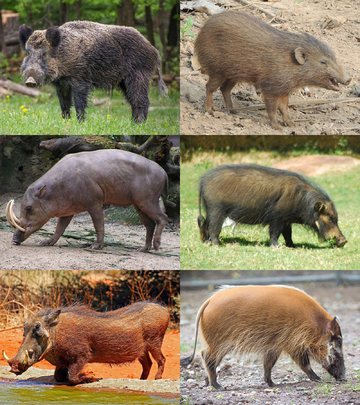 |
|
| Different kinds of suids; from top-left, clockwise: Wild boar, pygmy hog, giant forest hog, red river hog, common warthog, North Sulawesi babirusa | |
| Scientific classification |
|
| Kingdom: | Animalia |
| Phylum: | Chordata |
| Class: | Mammalia |
| Order: | Artiodactyla |
| Suborder: | Suina |
| Family: | Suidae Gray, 1821 |
| Type genus | |
| Sus Linnaeus, 1758
|
|
| Genera | |
|
Over 30 extinct genera, 6 extant, |
|
Suidae is a family of mammals that people commonly call pigs, hogs, or swine. These animals are known for their strong snouts and often bristly coats. Today, there are 18 different types of suids that are still alive. This includes the well-known domestic pig and many kinds of wild pigs. Other famous suids are babirusas and warthogs. All suids originally come from the Old World, which means places like Asia, Europe, and Africa.
The very first suids we know about from fossils lived a long, long time ago in Asia. Their relatives later moved into Europe. Scientists have found many fossil suid species. These fossils show that ancient suids ate many different things. Some were plant-eaters, while others might have even eaten dead animals.
Contents
What Makes Suids Special?
Suids are part of a group of animals called Artiodactyla. This group includes animals like deer and cows. Suids are thought to be very similar to the earliest animals in this group. Unlike most other animals in this group, suids have four toes on each foot. However, they usually walk only on their two middle toes. Their other toes stay off the ground. Also, suids have a simple stomach. Most other animals in their group have a more complex stomach for digesting plants.
Size and Appearance
Suids come in many sizes. The smallest is the pygmy hog, which is about 58 to 66 centimeters (23 to 26 inches) long. It weighs about 6 to 9 kilograms (13 to 20 pounds). The largest is the giant forest hog. It can be 130 to 210 centimeters (4.3 to 6.9 feet) long and weigh 100 to 275 kilograms (220 to 606 pounds).
Suids have big heads and short necks. They have small eyes but large, noticeable ears. Their most famous feature is their snout, which ends in a flat, disc-shaped nose. Most suids have a rough, bristly coat of hair. They also have a short tail that often ends in a tassel.
Senses and Diet
Suids have excellent hearing and are very vocal. They communicate with each other using grunts, squeals, and other sounds. They also have a very strong sense of smell. Many suid species eat a variety of foods. They are called omnivores. This means they eat grass, leaves, roots, insects, worms, and sometimes even small animals like frogs or mice. Some suids are more picky and only eat plants.
Their teeth are perfect for their diet. Unlike many other animals in their group, suids keep their upper front teeth. Their canine teeth grow very large and form strong tusks. These tusks are used for digging in the ground to find food. They also use them for fighting.
Behavior and Reproduction
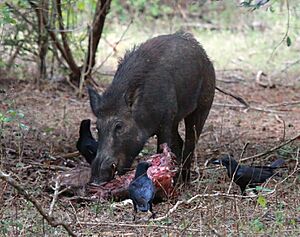
Suids are smart animals and can adapt to many different places. Adult female suids, called sows, and their young travel together in groups. These groups are called sounders. Adult male suids, called boars, usually live alone or in small groups of other males. Males usually do not fight over land. They only fight when it's time to mate.
Life Cycle and Young
The number of babies a mother suid has can be different for each species. It can range from one to twelve young at a time. The mother builds a nest out of grass or finds a safe den for her babies. The young suids leave the nest after about ten days. They stop drinking their mother's milk around three months old. They become old enough to have their own babies at about 18 months. However, in the wild, male suids usually don't get to mate until they are fully grown. This can take about four years. In all suid species, the male is much bigger than the female. Males also have bigger tusks.
Types of Suids
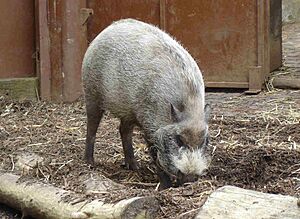
There are 18 different kinds of suids alive today. Here are some of the main groups and species:
| Image | Genus | Living species |
|---|---|---|
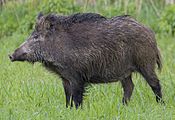 |
Sus – pigs |
|
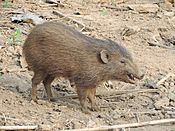 |
Porcula |
|
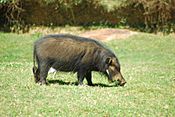 |
Hylochoerus |
|
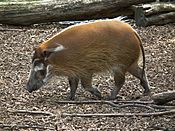 |
Potamochoerus |
|
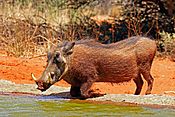 |
Phacochoerus – warthog |
|
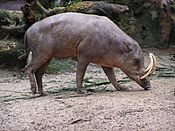 |
Babyrousa – babirusa |
|
See also
 In Spanish: Suidos para niños
In Spanish: Suidos para niños


